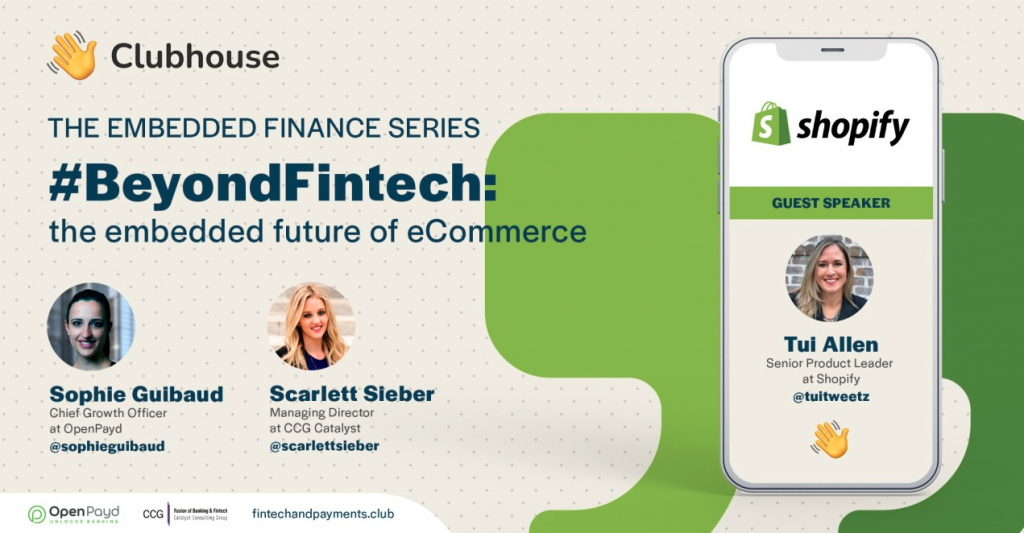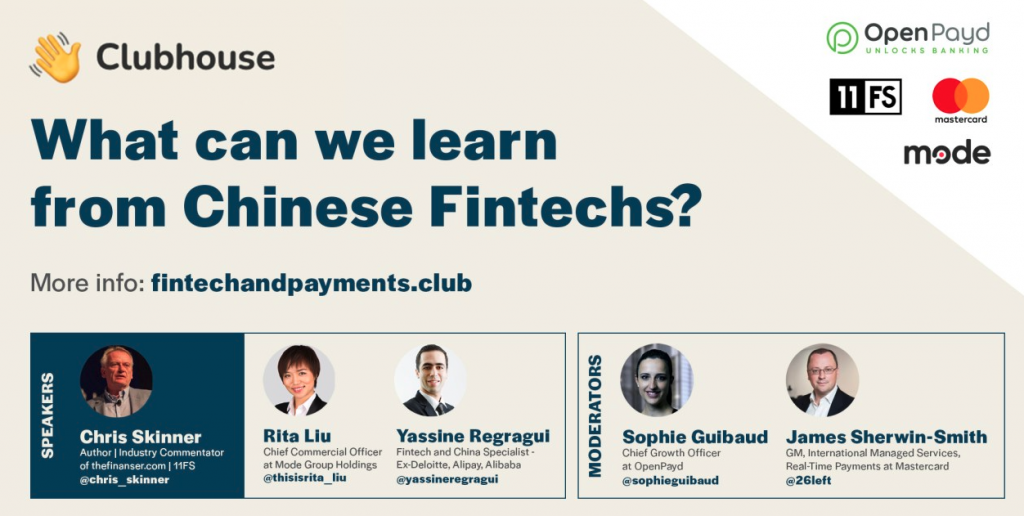
By Sophie Guibaud, Chief Growth Officer at OpenPayd ✨ BAAS & Embedded Finance
There are so many interesting ways in which finance is being embedded into commerce experiences right now. It was therefore a great privilege to cover this subject in our latest #BeyondFintech discussion on Clubhouse for the Fintech and Payments Club.
I was joined in this discussion by Tui Allen, Senior Product Lead at Shopify, and by my fellow moderator Scarlett Sieber, Managing Director at CCG Catalyst. Tui was the perfect person to talk us through the embedded future of commerce because of the market leading position that Shopify holds.
If you weren’t able to join the conversation, here are the main topics we covered and the key learnings I took from it.
Product development is ‘merchant obsessed’
Embedding finance into commerce is all about being ‘merchant obsessed’. This means trying to find ways to empower merchants with business finance tools and developing these tools by engaging with merchants throughout the product life cycle.
The product development process should define a problem to be solved, build prototype solutions and put them in front of merchants to test. At Shopify, low-fidelity and high-fidelity designs are used to gather feedback from merchants, so that product teams can iterate, improve and test them again. In this way, Shopify is acting like a startup by shipping quickly, moving boldly and engaging with customers throughout.
It is an approach that many banks should be looking to emulate too. While there are always regulations to be aware of, financial service providers need to evolve their product development processes so they engage their customer base and do not get stuck within their own headspace.
Partnerships should be win win
Shopify has partnered with Affirm for its ‘buy now, pay later’ offer. It has also partnered extensively with Stripe, including using the financial service provider’s Treasury service for Shopify Balance, their money management solution, currently in beta with select merchants and launching later this year.
Embedded finance partnerships within commerce need to offer mutual benefits for both parties if they are to be successful and companies should work with firms that share a similar DNA. Financial services is a complicated industry made up of many different layers, so the best finance partners are those with great reach who can minimise the number of layers an ecommerce provider needs to operate at.
Shopify has partnered with Stripe for a long time. The partnership works because Shopify wants to reinvent the banking experience for merchants. Therefore Stripe’s API-first strategy, as well as its innovative approach and willingness to ship products quickly, make it the perfect partner.
Embedded finance works in context
Making payments seamless for merchants was the starting point for Shopify but now it is providing a range of financial services to help its customers sell more, grow more and generally be more efficient and effective.
It does this by embedding these financial services within the context of the overall commerce experience. For example, it has Shop Pay to make the checkout process more efficient and to make it faster, easier and safer for consumers to manage delivery details, payment options and account settings all in one place.. It has also introduced Installments, its ‘buy now, pay later’ product, which allows customers to split payments at checkout. Installments is currently available to select merchants in beta and will launch later this year.
All of these developments tie in with the company’s aim of bringing commerce to where consumers spend their time. With main street becoming more and more digital, Shopify has partnered with Facebook, Instagram and TikTok to help sellers across North America, Europe and Asia develop their infeed shopping experiences.
Help to run a business, not just a shop
Part of being ‘merchant obsessed’ is understanding that the average entrepreneur or small business owner can struggle to manage their businesses finances. This is why Shopify is developing tools to help its merchants to understand their cash flow, access funding for growth and iron out any issues caused by delayed payments.
Shopify Balance, a money management tool, will include a Balance Account, fast access to funds, a Shopify Card, and a rewards program that is uniquely built for merchants and their business essential spending. This is also just one example of how data enables Shopify to help its merchants to make smart decisions about their money and rewards them for doing so.
Because a small business owner may be a creator, builder or seller before they are a finance specialist, Shopify is trying to help them with this important area of business. Therefore it uses data to highlight when it might be a good time for a merchant to access some extra cash through its funding solution, Shopify Capital, and then reduces the barriers that might stop them from accessing this funding, such as lengthy applications or credit review processes.
Financial services that meet business needs
As mentioned, data is what enables Shopify to help its merchants with the specific financial services they need and to do so in the context of the ecommerce experience.
Shopify Capital enables merchants to access funding for growth and uses data to help suggest the right solution for a business’s specific circumstances. This might involve highlighting seasonality in sales or cash flow, such as when a fashion brand could access funding to buy fabric and prepare for its main sales period. In 2020, it involved extending the product to businesses in Canada and the UK for the first time and providing an additional $200 million in funding, to help merchants deal with the effects of the pandemic. As of February 2021,, Shopify Capital has provided $1.7 billion in funding to merchants since its launch in 2016.
Shopify Balance has also been designed around merchant needs rather than to compete with what existing financial service providers offer. Traditional banking products are often designed for big institutions but Shopify wants to help small business owners gain control of their money and manage it in a way that helps boost growth.
Social shopping is a major global trend
Global expansion is a major priority for Shopify and the social shopping trend is likely to play a big part in how that occurs. The partnerships with Facebook, Instagram and TikTok are all examples of this and they will result in fintech being provided in the context of where customers are engaged.
Achieving this will look different in different parts of the world because of the different audiences involved and because the world is still siloed when it comes to financial regulation. For this reason, moving into a highly regulated region could mean that partnering with a financial service provider is a better option than building a solution organically.
Regulation will always dominate how financial services work around the world and it’s something that commerce providers must always consider. Even though global payments and cross border selling have become easier in recent years, the finance industry as a whole still has work to do to make embedded finance possible on a global scale.
Want to follow more discussions like those?
1.Visit the Fintech & Payments club website to be informed of daily events. The Fintech & Payments club comprises 30,000 members and followers on Clubhouse, growing every day. We run events every day on a variety of Fintech topics!
2. Follow me on Linkedin for new updates and live session write-ups.
3. Subscribe to my substrack to follow my new series Beyond Fintech, exploring how Brands leverage Fintech to unlock new growth opportunities.


